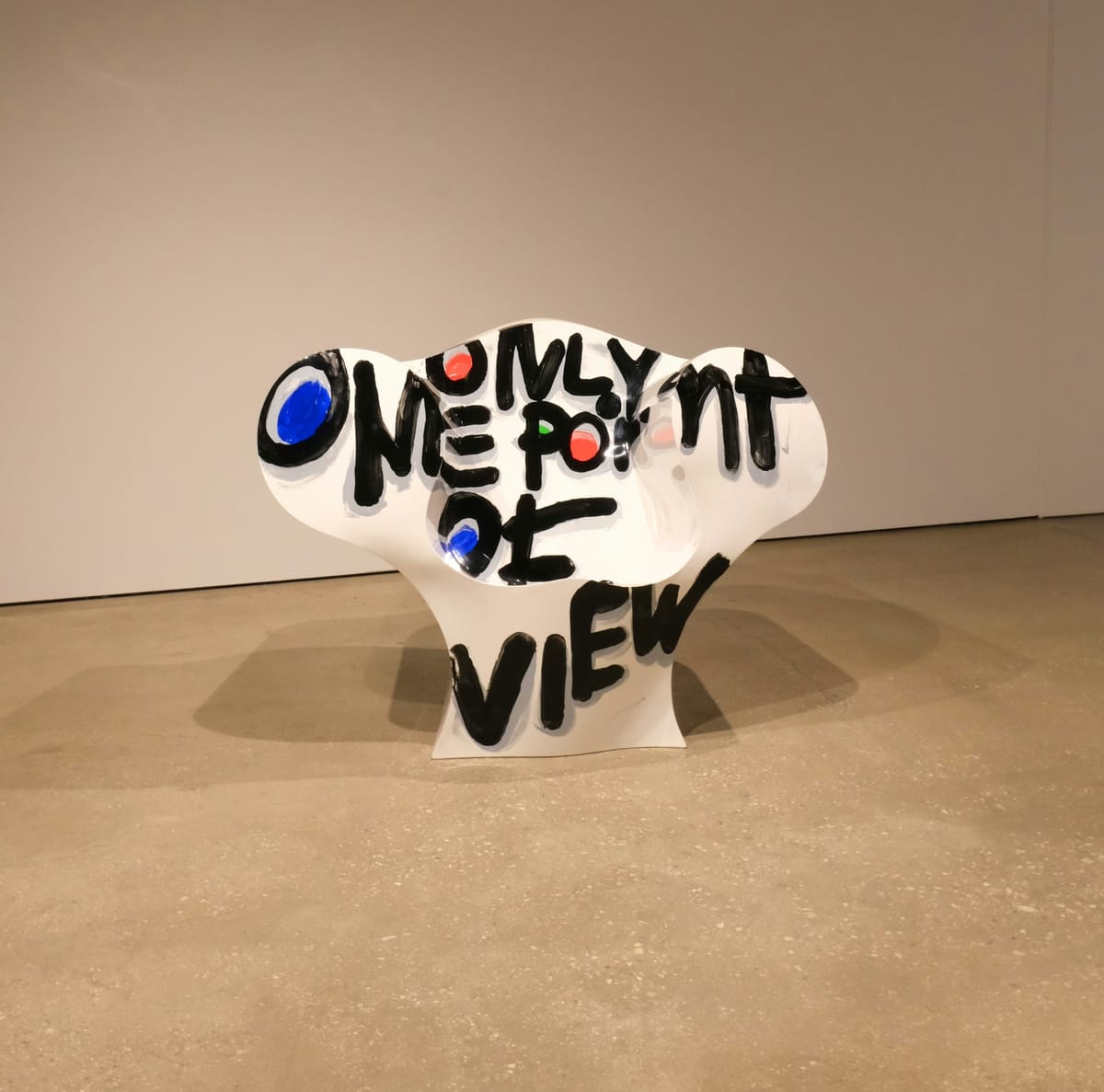Entering the Space that Doesn’t Exist
“My painting floated mid-air. The wall didn’t exist. I called it conceptual and moved on. No one came. Not even my mother. She replied with a single emoji: 🤨. Create your first exhibition today,” the homepage said. “It’s free,” they lied. I paid €12 to preview my loneliness in 3D.

A paranoid artist’s descent into VR galleries, empty rooms, and the algorithmic abyss by an anonymous contributor (for reasons of national security, and also my ex works at Meta)
It started right away with a wall that wasn’t there. I tried to hang a painting in a virtual gallery and ended up pinning it to air, suspended in a void where it made no sense and had no support. At that point, I should’ve stopped, taken a step back, and reconsidered my approach.
But like any delusional artist clutching at post-pandemic relevance, desperate for validation in an increasingly digital world, I had a dream: To exhibit my work online—professionally, beautifully, globally—without being financially destroyed, technically humiliated, or psychologically unmade by the cold logic of algorithms or the sterile emptiness of virtual spaces. I yearned to bridge the gap between traditional artistry and the new virtual frontier, hoping to find an audience that could appreciate my creations without the constraints and cruelties of physical galleries or social media platforms.
Just a modest dream.
I log in, therefore I cry
“Create your first exhibition today,” said the homepage. “It’s free,” they lied.
I registered on Artsteps. It took two minutes. Then two hours. I tried to place a painting on a wall. The wall didn’t exist yet. I had to build it. I selected a texture: “Concrete. Mood: Oppressive.” I immediately felt unsafe.
I uploaded a sculpture. Only a photo of it, really. The platform asked: “Would you like to upload a .glb 3D file?” I said yes. Then ran to Google what that was. After 30 minutes of spiritual defeat, I had uploaded the image as text. The sculpture was now a paragraph. I left it like that. Conceptual, I muttered.
And then I tested the VR mode.
My painting hovered 80 centimeters above the floor. The shadows pointed west. One of the works had its back to the viewer. I tried to move forward using arrow keys and my mouse wheel. I dry heaved. But I shared the link. No one came.
Not even my mother. She replied with a single emoji: “🤨”.

The Metaverse and Other Nightmares
I moved on. I tried Kunstmatrix. It was cleaner. I selected a room called Classic Gallery 01. It looked like a dentist’s office trying to impress a curator. I uploaded some works. I tried to rotate one by 90 degrees. Everything collapsed into digital purgatory. I hit “Preview.” It asked me for €12. I paid. Then it asked me to upgrade. I logged out.
Then I discovered Spatial. They had avatars. You could walk around and talk to people. It was like queer Second Life, but with less shame and better lighting.
I created a space. Uploaded images. Built a gallery. Everything worked. I cried.
And then I stood there. Alone. In a beautiful virtual room filled with my own art. Like an existential NPC. I waited for visitors. No one came. But I could hear the wind. Or maybe that was my CPU dying.

The Audience Is a Lie
Here’s the thing: VR is sexy. It feels avant-garde. It’s immersive and theatrical. But 98% of your audience doesn’t own a headset. 70% won’t click a link if it requires more than two fingers. The remaining 2% work in crypto and want to turn you into a token.
I tried OnCyber. The interface welcomed me with: “Connect your wallet.” I offered my debit card. It recoiled. I minted an NFT just to try it. Suddenly I was part of a blockchain I didn’t understand. I had sold myself to myself—for 0.0038 ETH.
There is now a “ME Genesis Drop” somewhere in the Ethereum fog. - It’s worth slightly less than a latte and a modest panic.
The Cost of Showing Up Online
Artsteps is free—until it’s not. Exhibbit looks like a Monaco gallery, but they charge $50/month just to open the virtual door. Kunstmatrix is basically IKEA for galleries, except every drawer is locked until you upgrade. Spatial is kind, but there’s branding everywhere, like an AR Coca-Cola tattoo. Mozilla Hubs is technically free, but you’ll need a server, a manual, and possibly a cousin who codes.
And what do you get?
A room.
A link.
A hope.
A clickthrough rate of 1.4%.
And the ability to say in an interview:
“The exhibition is also available virtually.”
Which usually means: no one came in person.

Star Agency is always looking for great talent
Search for scandinavian streamingheroes.
I love the idea that someone—anyone—anywhere in the world can walk through my gallery. I love that. I also hate it.
Because it means they are never really there. They are always potentially arriving. Suspended in the maybe. Lost in buffering.
Still, maybe that’s the point. Maybe that’s why we build these strange, empty digital rooms. Not because we expect a crowd. But because we believe in presence. That the gallery exists. That the walls hold. That the art is hanging—even if the guests are theoretical.
Maybe that’s enough.
So what should you do, dear reader?
If you’re like me—neurotic, visual, medium-technically functional—and you want to make a virtual gallery:
Do it. Not because you think people will come. But because there’s power in creating the room anyway. A space. A vibe. A digital window where your work exists—beautifully, professionally, alone but glowing.
And if someone asks where to find it, just whisper:
“It’s right over there. After the third meta-instance. Behind the hope.”
If you'd like to buy prints, you’ll find the shop linked inside a polygonal corridor somewhere between despair and clickbait.

Let’s not pretend this is impartial. I’m sleep-deprived, emotionally attached to my own JPEGs, and mildly allergic to software updates. That said, here’s a side-by-side comparison of the main platforms I tested during my descent into the digital artscape.
Whether you’re a painter, sculptor, diorama hoarder, or conceptual art goblin—this guide is for you.
What You Pay (in Real and Imaginary Money)
| Platform | Free Version? | Cheapest Paid Option | Max Monthly Cost | Hidden Fees / Traps |
|---|---|---|---|---|
| Artsteps | ✅ Yes | $10/mo (for private shows) | Variable | UI therapy not included |
| Kunstmatrix | ❌ Trial only | €10 (~$12/mo) | €50+ for big plans | Pay to publish public |
| Exhibbit | ❌ Trial only | $15/mo (Solo Gallery) | $100+ for big rooms | Luxury comes with price tags |
| Spatial | ✅ Yes | $8/space/month (Pro) | $80+ for business | Freemium-friendly |
| OnCyber | ✅ Yes | Free, but needs NFTs | “ETH” lol | You pay in gas and dignity |
| Mozilla Hubs | ✅ If DIY | Free (self-hosted) | Custom (AWS fees) | Requires your soul or a dev friend |
Device Friendliness
Spoiler: your mobile viewers will still suffer.
- Artsteps: Works on mobile, but UI is fragile. Best on desktop with tea and patience.
- Kunstmatrix: Semi-okay on mobile, but wonky interactions.
- Exhibbit: Surprisingly slick on both phone and desktop.
- Spatial: Fully responsive, mobile app available, actual joy to use.
- OnCyber: Looks great, heavy on phone browsers.
- Mozilla Hubs: Technically works, practically melts weaker phones.
Sales Features
If you want to actually make money (ha!), here’s what they offer:
| Platform | Can You Sell? | How? | Who Takes a Cut? |
|---|---|---|---|
| Artsteps | ✅ Indirectly | Add links or emails in the wall text | No one – if you survive |
| Kunstmatrix | ✅ Yes | Built-in shop system | You keep sales, pay subscription |
| Exhibbit | ✅ Best | Purchase buttons, prices on walls | Zero commission – gold star |
| Spatial | ✅ Sort of | Link out to shops or use NFT plugins | Only on premium |
| OnCyber | ❌ Not for physical | NFT marketplace only | Blockchain + sorrow fees |
| Mozilla Hubs | ❌ | Hack your own system in | No cuts, no guidance, no rules |
Best Use Cases
| You Are... | Your Platform |
|---|---|
| A painter who wants a free VR room | Artsteps or Spatial (Free) |
| A gallery with a budget and many works | Exhibbit or Kunstmatrix |
| A crypto-native Web3 evangelist | OnCyber |
| An experimental theatre artist with code | Mozilla Hubs |
| Someone who wants to host a live vernissage | Spatial or Hubs |
| A tired sculptor who wants it to just work | Exhibbit or Spatial |

Final Thoughts (Before I Disappear Again)
If I had to pick?
🧨 Use Spatial if you want interaction, accessibility, and a soft-landing.
🧨 Use Exhibbit if you want luxury, and have €50/month and a God complex.
🧨 Use Artsteps if you’re emotionally prepared to troubleshoot your own reality.
And above all—don’t fall into the trap of perfectionism. Virtual galleries are never done. They exist in a quantum state of almost there.
So go on. Open the portal. Invite people in. Then stand quietly by the digital doorway, pretending it’s full. I’ll be doing the same. Under an anonymous avatar. Behind a .glb file.
Waiting for someone to click.
